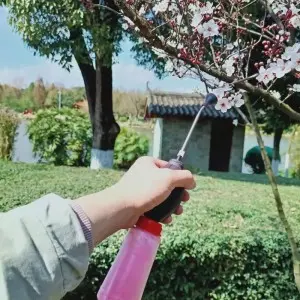nov. . 11, 2025 10:01 Tagasi nimekirja
Artificial Pollination Tools: Pure Plant Pollen, High Yield
If you’ve walked an orchard at dawn, you know bloom windows don’t wait. That’s why the future of Artificial Pollination looks a lot like a lithium pack, an efficient motor, and a clean powder plume.

Meet the LITHIUM ELECTRIC POLLINATOR FOR ORCHARD from Caozhuang Development Zone, Fanzhuang Town, Zhao county, Shijiazhuang, Hebei Province. After five years of R&D and a granted international utility model patent, the system pairs a lithium battery, electric motor, powder storage tank, and extension rod to deliver precise pollen where bees and wind sometimes can’t. It’s purpose-built for mid-size orchards (≈10–20 mu; roughly 1.6–3.3 acres). To be honest, the timing is perfect—growers tell me labor’s tight, bloom timing is erratic, and yields can’t be left to chance.
Industry trend check (quick):
Declining wild pollinators, volatile spring weather, and rising labor costs are pushing mechanized Artificial Pollination. Battery tools have matured, and farms want repeatable deposition, traceable quality, and standards-backed safety.
Process flow: materials, methods, testing
Materials: lithium-ion battery pack; high-efficiency DC motor; powder tank (food-grade polymer, typically PP/ABS); anodized aluminum/steel rod; anti-static nozzle. Methods: dry, sieved pollen (or pollen-carrier mix) filled into tank; set flow rate; walk row at constant pace, keeping nozzle ≈20–40 cm from flowers. Ideal ambient RH: 40–65% for deposition. Testing: pollen viability checked by TTC staining or in vitro germination; equipment safety validated to UN38.3 (transport), IEC 62133 (cell/pack safety); ingress protection target around IP54. Typical service life: 3–5 seasons for the tool body with routine maintenance; batteries ≈300–500 cycles in real-world use.
| Spec (≈, typical) | ELEKTRILINE LIITIUM-TOLMELJA AIAAIALE |
|---|---|
| Battery | Lithium-ion pack; 18–24 V class; UN38.3 compliant |
| Runtime | ≈3–6 hours per charge (use-dependent) |
| Tank volume | ≈0.5–1.5 L (pollen or blend) |
| Rod length | ≈1.2–2.0 m, extendable |
| Flow control | Stepless dial or stepped settings |
| Unit weight | Around 3–6 kg |
| Noise | ≈60–75 dB |
| Ingress protection | Target IP54 (dust/splash), real-world use may vary |
| Certs (typical) | CE, RoHS; battery per IEC 62133 |
| Warranty | Commonly 12 months; parts support available |

Where it shines
Apples, pears, kiwi, cherries, almonds; open field or greenhouse; hillside blocks where sprayers struggle. Many customers say they like the quick start/stop and precise dosing. One manager told me, “We finally schedule bloom work by the hour, not the weather.” That’s the quiet power of Artificial Pollination done right.
Mini case study (Hebei, 15 mu pears)
Two passes (20% and 70% bloom). Crew of 2 covered ~15 mu in a morning. Fruit set averaged 66–70% vs. prior-year 50–55% (weather was similar). Pollen use dropped ≈25% thanks to even deposition. Obviously, results vary with cultivar and bloom conditions—but the time savings were undeniable.
| Vendor/Method | Efficacy (fruit set) | Labor/hr per mu | Pollen efficiency | Certs/Standards |
|---|---|---|---|---|
| JML Lithium Electric Pollinator | High (field-dependent) | Low | High (reduced waste) | UN38.3, IEC 62133, CE/RoHS (typ.) |
| Generic blower-based handheld | Medium | Medium | Medium | Varies by maker |
| Manual brush/sachet | Variable | High | Low–Medium | N/A |

Customization and compliance
Options often include: nozzle sizes, extended rods, extra batteries, larger tanks, farm branding. Documentation: CE/RoHS declarations, UN38.3 battery test summary, and quality systems (e.g., ISO 9001) on request. Recommended QC: incoming pollen purity/viability testing; on-farm spray cards or deposition strips to validate coverage; annual electrical safety checks.
Practical tips
- Pass at 10–30% and 60–80% bloom for many pome crops (local guidance rules).
- Keep pollen cool and dry; don’t overfill the tank.
- Log battery cycles; rotate packs to extend life.
Bottom line: with disciplined setup and good bloom timing, Artificial Pollination gear like this turns a risky week into a planned operation.
Authoritative citations
- IPBES. The Assessment Report on Pollinators, Pollination and Food Production (2016).
- FAO. Pollination services for sustainable agriculture—guidelines and case studies (2018).
- IEC 62133. Secondary cells and batteries containing alkaline or other non-acid electrolytes—Safety requirements.
- UN Manual of Tests and Criteria, Section 38.3 (UN38.3) for lithium batteries.
- UC ANR/UC Davis. Orchard pollination and fruit set guidelines (various bulletins).
- ISO 9001:2015 Quality management systems—Requirements.
-
Apple Tree Pollen for Sale – Fresh, High Viability, Fast
UudisedNov.20,2025
-
CE Certification Netting Bags for Fruit Trees: Durable & Reliable
UudisedNov.20,2025
-
Premium Pear Tree Pollen — High Viability for Bigger Yields
UudisedNov.20,2025
-
Functions and Applications of Fruit Protection Bags
UudisedNov.20,2025
-
kiwipollen: Premium Kiwi Pollen, High Viability & Cold-Chain
UudisedNov.20,2025
-
Apple Tree Pollen for Sale – Fresh, Pure, Fast Shipping
UudisedNov.20,2025